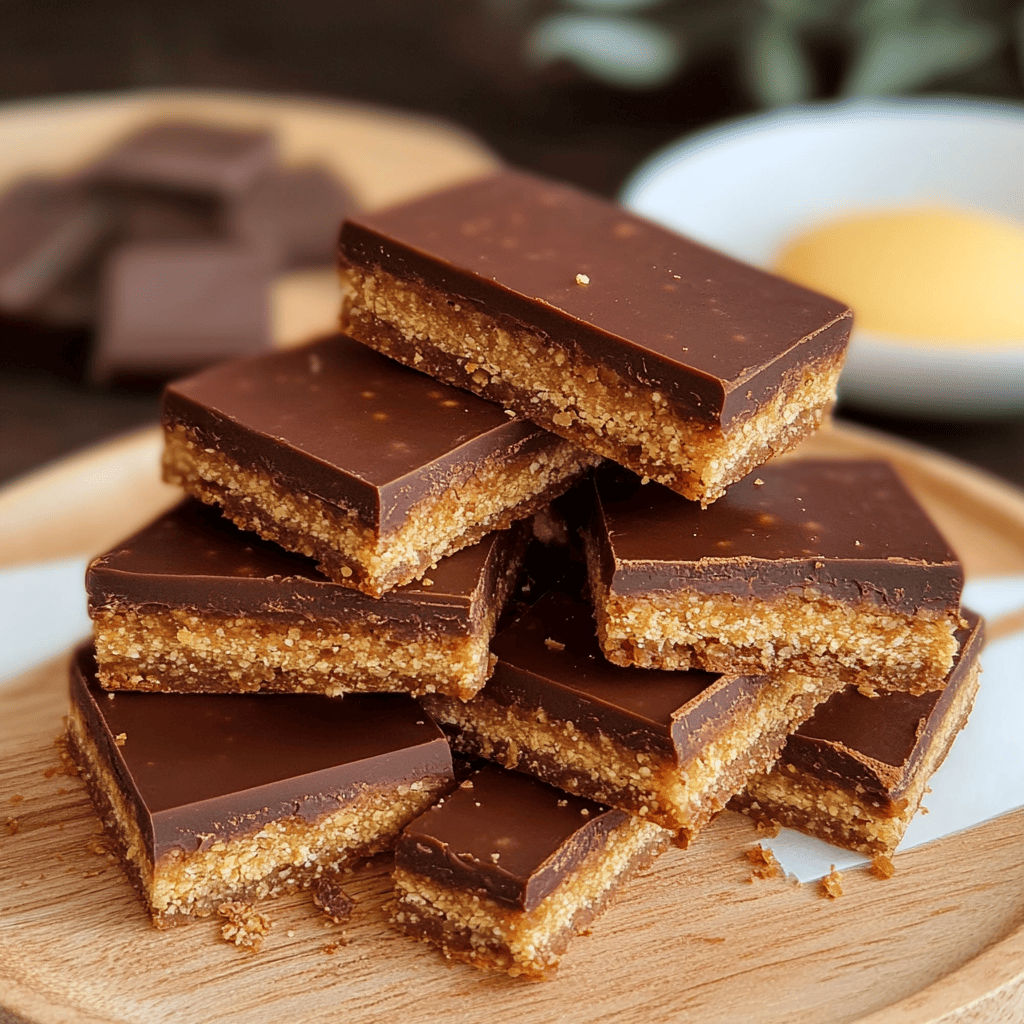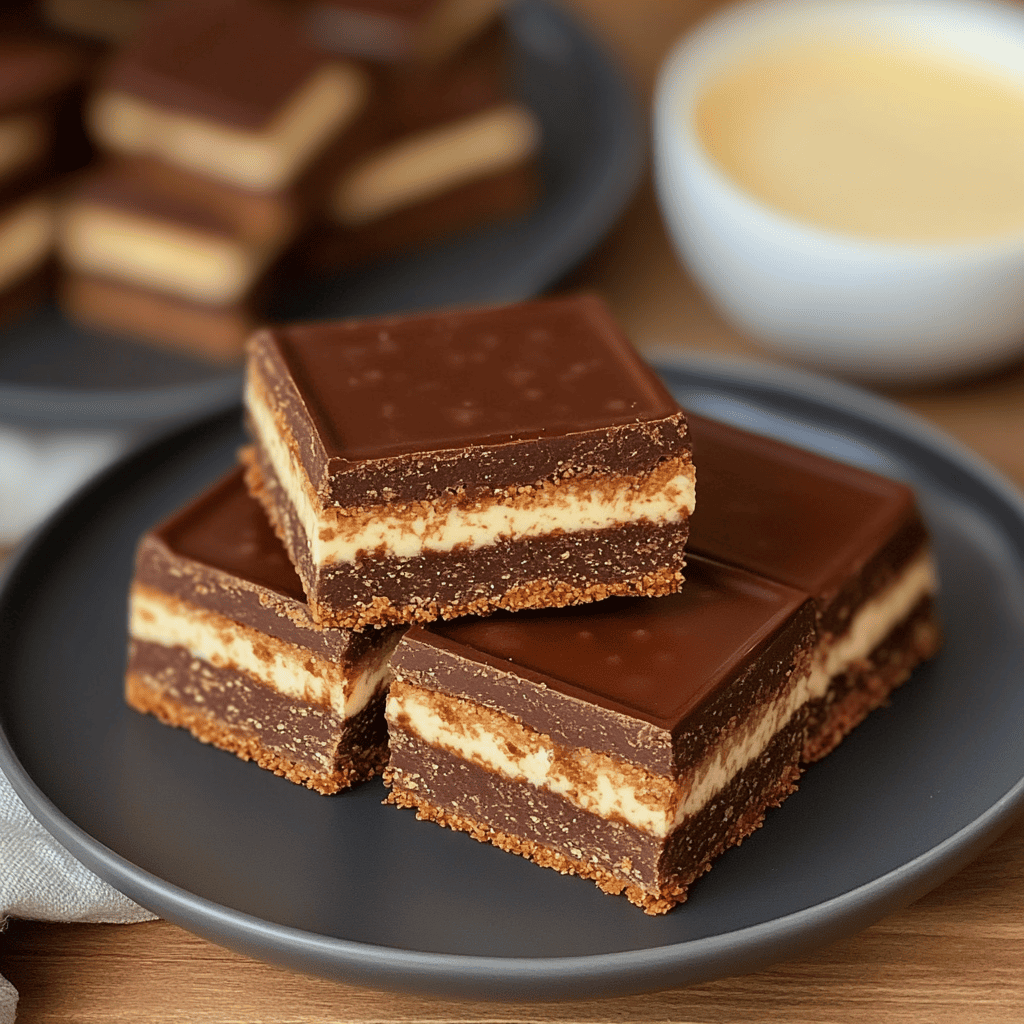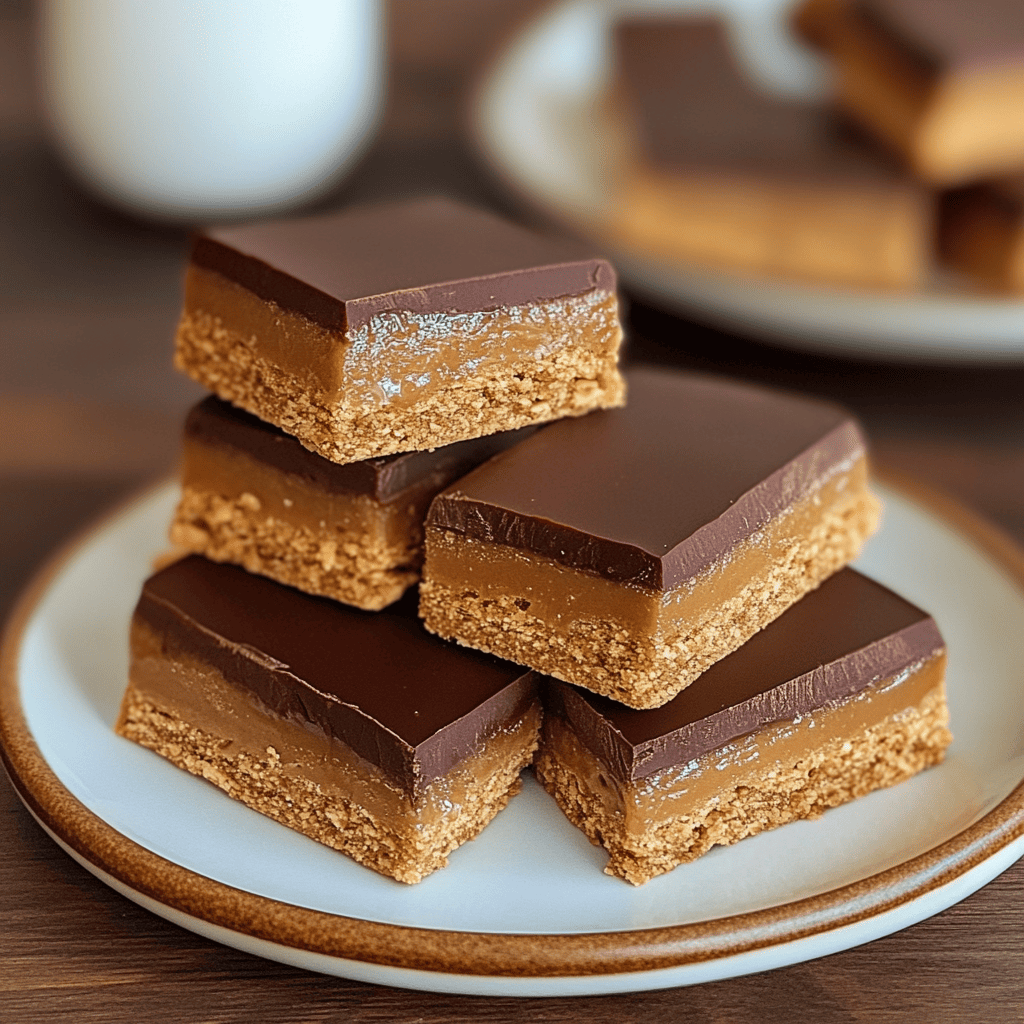Bajadera (No-Bake Chocolate Peanut Butter Bars): A Feast of Irresistible Layers
Introduction: The Elegance of Simplicity and Intense Flavor
Bajaderas, or no-bake chocolate and peanut butter bars, are a dessert that combines the richness of chocolate with the creaminess and distinctive flavor of peanut butter, all arranged in visually appealing layers. Their main feature is that they don’t require baking, making them an ideal choice for quick and easy preparation, especially in warm climates or when looking for an indulgent dessert without the hassle. The combination of textures, from the firm base to the smooth filling and shiny chocolate coating, makes them an irresistible treat for any sweet tooth. Discover all the secrets of this delicious and convenient creation!
Detailed History in Spanish: From Balkan Origins to Global Adaptation
Bajadera is a traditional Balkan dessert, especially popular in Croatia and Serbia. Its name, Bajadera, refers to oriental dance and the beautiful layers, reminiscent of the dancers’ elaborate costumes. Traditionally, the Balkan Bajadera doesn’t always include peanut butter and is often made with a base of crushed biscuits, nuts, and chocolate, with a layer of cream or caramel and a chocolate coating. It’s a dessert that evokes nostalgia and is a classic at celebrations and parties.
The Origin of No-Bake Bars: The idea of no-bake desserts became popular in the United States, especially during the Great Depression and World War II, when access to ingredients and baking time were limited. These desserts offered an ingenious way to create satisfying sweets with minimal resources.
The Incorporation of Peanut Butter: Peanut butter is a popular ingredient in American baking, known for its unique flavor and ability to pair well with chocolate. No-bake chocolate and peanut butter bars emerged as an adaptation of “no-bake” desserts, using peanut butter as the main ingredient to create a creamy and flavorful filling.
The recipe presented here, with a cookie or cookie-like base, a creamy peanut butter filling, and a chocolate layer on top, is likely a fusion of the American no-bake bar tradition with the visual influence and popularity of Balkan Bajaderas, or simply an independent evolution of peanut butter and chocolate bars. This dessert is a testament to how culinary ideas travel and transform, adapting to the tastes and availability of ingredients in different cultures.
More Historical Detail: Modern Influences and Adaptations
Delving a little deeper into the history of these bars, we can consider some influences:
- Layered Desserts: The idea of layered desserts, like Italian tiramisu or English trifles, is a constant in pastry making. Bajadera joins this tradition with its distinct flavor and color spectrum.
- Diaspora and Culinary Fusion: As people move around the world, their culinary traditions travel with them. Bajadera’s popularity in other parts of the world, beyond the Balkans, may be due to the diaspora and the adaptation of traditional recipes with local or trendy ingredients.
- The No-Bake Trend: The demand for quick and easy recipes that don’t require an oven has grown exponentially with today’s busy lifestyles. No-bake bars fit this trend perfectly, offering indulgence with minimal effort.
- The Classic Chocolate-Peanut Duo: The combination of chocolate and peanut butter is a beloved classic in many cultures, especially in North America. No-bake bars capitalize on this popularity to create an irresistible dessert.
Today, there are countless variations of these bars, with different types of cookies for the base, additions to the filling (such as chopped nuts, caramel, or marshmallows), and various types of chocolate for the coating. The one pictured appears to be a more modern version that focuses on the textures and color contrast of the layers.

Ingredients & Detailed Preparation
Ingredients (Chocolate and Peanut Butter Bar Version):
For the Base (Bottom Layer):
- Digestive biscuits or graham crackers: 200 g
- Unsalted butter, melted: 100 g
- Unsweetened cocoa powder: 2 tablespoons (optional, for a more chocolatey flavor)
For the Peanut Butter Filling (Middle Layer):
- Unsalted butter (at room temperature): 120 g
- Creamy peanut butter: 200 g
- Icing sugar (powdered sugar): 150-200 g (adjust to taste)
- Vanilla extract: 1 teaspoon
- Milk (optional, if the filling is too thick): 1-2 tablespoons
For the Chocolate Coating (Top Layer):
- Semi-sweet or milk chocolate: 200 g
- Unsalted butter: 30g (or 1 tbsp coconut oil for extra shine)
Detailed Preparation:
- Prepare the mold: Line a square or rectangular mold (approximately 20×20 cm or similar) with baking paper, leaving the edges hanging over to make it easier to remove from the mold.
- Prepare the base: Grind the cookies into fine crumbs. You can do this in a food processor or by placing them in a bag and crushing them with a rolling pin.
- In a medium bowl, combine the cookie crumbs with the melted butter and cocoa powder (if using). Mix well until the crumbs are evenly moistened.
- Firmly press the cookie mixture into the bottom of the prepared pan, creating an even, compact layer. Refrigerate while you prepare the filling.
- Prepare the peanut butter filling: In a large bowl, beat the room temperature butter until smooth and creamy.
- Add the peanut butter and sifted powdered sugar to the butter. Beat on low speed until combined, then increase speed and beat until the mixture is smooth and fluffy.
- Stir in the vanilla extract. If the mixture is too thick, you can add one or two tablespoons of milk to achieve a spreadable consistency.
- Assemble the layers: Spread the peanut butter filling evenly over the packed cookie crust in the pan. Smooth the surface with a spatula.
- Refrigerate the mold with the base and filling for at least 30 minutes to set a bit while you prepare the chocolate coating.
- Prepare the chocolate coating: In a microwave-safe bowl or over a double boiler, melt the chopped chocolate together with the butter (or coconut oil), stirring occasionally until the mixture is smooth and shiny.
- Topping the bars: Pour the melted chocolate over the peanut butter layer and gently spread it with a spatula to create an even layer.
- Refrigerate to set: Refrigerate the mold for at least 1-2 hours, or until the chocolate layer is completely firm.
- Cut and serve: Once the chocolate coating has set, remove the baking paper from the pan. Using a sharp, warm knife (you can run it under hot water and dry it), cut the bars into individual pieces. Wipe the knife clean after each cut to ensure clean edges.
- Enjoy: Serve the Bajaderas cold and delight in every bite.
Estimated Preparation Time
- Active preparation: 25-35 minutes
- Total cooling time: Minimum 1.5 – 2.5 hours (longer is better for layers to set properly)
- Total time: Approximately 2 – 3 hours (including cooling)
Additional Tips
- Quality Ingredients: Use good quality ingredients, especially chocolate and peanut butter, as their flavor will be prominent.
- Alternative cookies: You can use other types of dry cookies for the base, such as vanilla cookies or even chocolate cookies for a more intense flavor.
- Customize the sweetness: Adjust the amount of powdered sugar in the filling to your preference. If you use pre-sweetened peanut butter, you may need less sugar.
- Coating consistency: If the melted chocolate is too thick, you can add an extra teaspoon of butter or coconut oil to make it easier to spread.
- Storage: These bars are best stored in the refrigerator in an airtight container.
- Variations:
- With white chocolate: You can make one layer of white chocolate instead of dark chocolate, or even make two thin layers, one of milk chocolate and one of white chocolate.
- Nuts: Add chopped nuts (such as almonds, walnuts, or hazelnuts) to the crust or filling for an extra touch of flavor and texture.
- Salty touch: A pinch of coarse sea salt sprinkled over freshly spread chocolate coating can enhance the flavors.

Frequently Asked Questions
- Can I substitute the peanut butter for another nut butter? Yes, you can use almond, cashew, or any other creamy nut butter. The final flavor will vary.
- Do these bars need to be refrigerated? Yes, refrigeration is crucial for the layers to harden and the bars to hold their shape. Plus, the cold enhances their flavor and texture.
- How long do Bajaderas keep? Stored properly in an airtight container in the refrigerator, they can be kept for up to a week. They can also be frozen for longer.
Texture and Flavor
The texture of these Bajaderas is a delicious combination of contrasts. The cookie base is firm and slightly crunchy. The peanut butter filling is smooth, creamy, and creamy. The top chocolate layer is firm, yet melts smoothly in the mouth, providing a silky sensation.
The flavor is a harmonious explosion of chocolate and peanut butter. The sweetness is balanced by the slight bitterness of cocoa and the salty, toasty flavor characteristic of peanut butter. It’s an indulgent, rich, and deeply satisfying dessert.
Consumer Context
These Bajaderas are ideal for various occasions:
- Parties and gatherings: Their individual serving sizes make them perfect for dessert tables.
- Quick and easy dessert: When you don’t have time to bake, but want a delicious dessert.
- Indulgent snack: Perfect with coffee or tea.
- Edible Gift: Packaged in a pretty box, they make a lovely homemade gift.
- For chocolate and peanut butter lovers: A real delight for fans of this combination.
Visual Aspect
Bajaderas are visually very appealing due to their well-defined layers. The dark brown of the base contrasts with the lighter, creamier tone of the peanut butter filling, and the whole thing is crowned by a smooth, shiny chocolate layer. The clean, straight edges of the individual portions enhance their elegant and sophisticated appearance.
Curiosities
- The origin of peanut butter: Peanut butter has been used for centuries in various cultures, but its popularization in the Western world as a common food occurred in the late 19th and early 20th centuries.
- The “no-bake” reaction: No-bake desserts often use ingredients that solidify when frozen (such as butter, chocolate, or mixes containing gelatin) to achieve their final texture.
- Traditional Bajadera: The original Balkan Bajadera is often made with Plazma biscuits (a popular type of biscuit in the region) and chocolate, with a rum or cognac base.
Nutritional Value (Estimated per Serving)
Please note that these values are approximate and may vary significantly depending on the serving size and exact amounts of ingredients used. These are calorie-dense desserts.
- Calories: 250-350 kcal
- Protein: 5-8 g (mainly from peanut butter and cookies)
- Fat: 18-25 g (mainly from butter, peanut butter and chocolate)
- Saturated fat: 10-15 g
- Carbohydrates: 20-30 g (mainly from sugar and cookies)
- Sugars: 15-25 g
- Fiber: 1-2 g
- Sodium: Variable (depending on the salt in the peanut butter and cookies)
Additional Benefits and Interesting Facts
- No oven required: Perfect for summer or for those without an oven.
- Classic flavor combination: Chocolate and peanut butter are a duo that most people love.
- Can be prepared in advance: Ideal for organizing a stress-free dessert table.
Other Information
- Storage: Store bars in an airtight container in the refrigerator.
- Serving Temperature: Best enjoyed cold, straight from the refrigerator.
- Variety of chocolates: You can use semi-sweet chocolate, milk chocolate, or even a mix for the coating, depending on your preference.

Conclusion: A Bite of Indulgence Without the Hassle
Bajaderas, or no-bake chocolate and peanut butter bars, are a truly versatile and delicious dessert. Their ease of preparation, harmonious flavors, and attractive layered presentation make them a winning choice for any occasion. Whether for a personal treat or to share at a get-together, these bars promise a sweet and satisfying experience without having to turn on the oven. Go ahead and make them and enjoy this irresistible layered treat!

